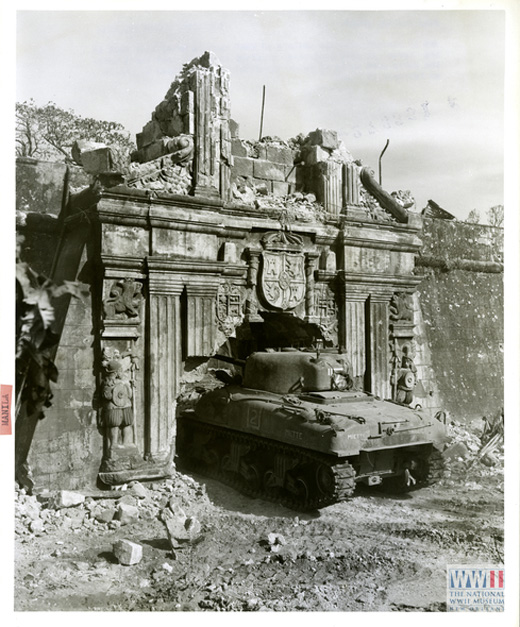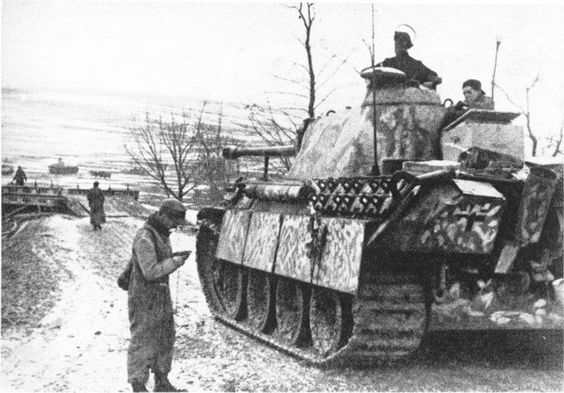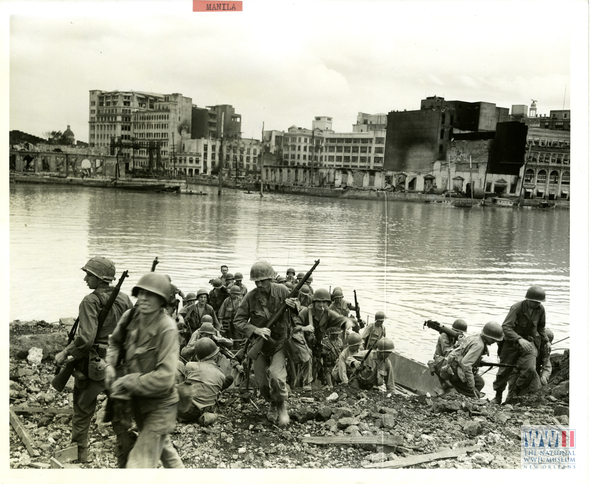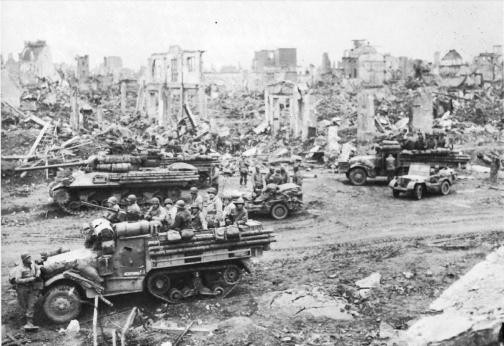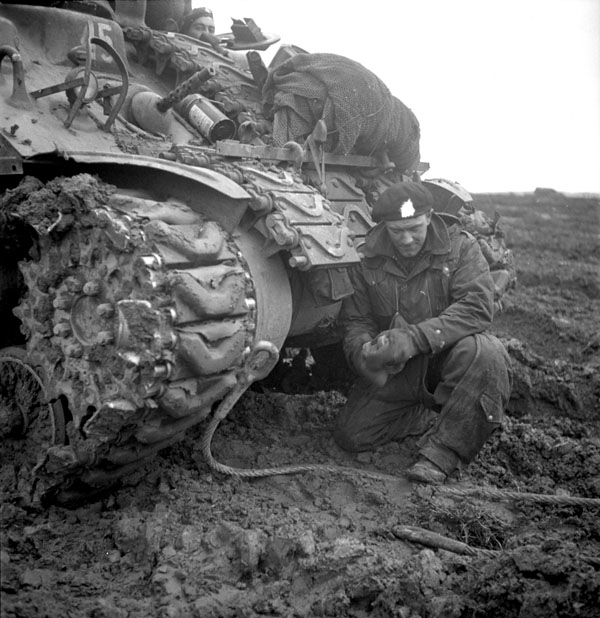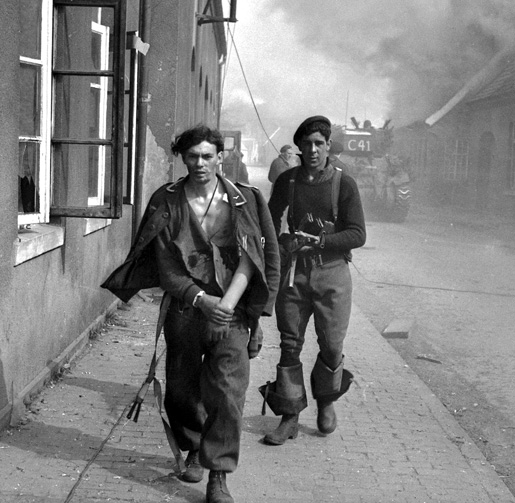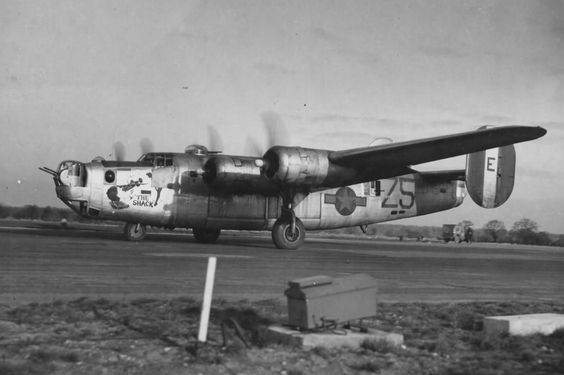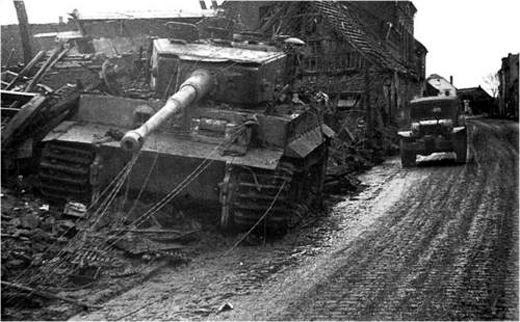Air Operations, CBI
BURMA- 4 10th Air Force B-25s and more than 80 fighter-bombers attack targets immediately behind Japanese Army battle lines.
- 4 B-25s attack bypass bridges at 2 locations at low level.
- 16 P-47s support Chinese Army ground forces near Namhsan.
- 8 P-47s support US Army ground forces near Lashio.
- 12 P-47s support British 14th Army ground forces near Mongmit.
- 2nd Air Commando Group P-47s down 2 Ki-43 'Oscar' fighters over Sedo and near the Meiktila airfield at 1115 hours.
- 20 341st Medium Bomb Group B-25s attack Ishan, Luchai, Siangtan, and bridges at Chochou and Loshan.
- 70 14th Air Force fighter-bombers attack airfields, occupied towns, transportation targets, and targets of opportunity across southern and eastern China and northern French Indochina.
Air Operations, East Indies
XIII Bomber Command B-24s attack the Manggar and Sepinggang airfields on Borneo.
[Air Operations, Europe
The 8th Air Force carries out a 3,000 ton(?) raid on Berlin. A half million incendiaries are dropped. The main targets are the 3 railway stations. 15 bombers and 7 escorts are lost. RAF Mosquitoes bomb Berlin by night, guided by the fires started by the Americans.
RAF BOMBER COMMANDDaylight Ops:
- 149 Lancasters of No. 3 Group carry out a G-H attack on the Hoesch benzol oil plant at Dortmund through cloud. No results are seen, but the bombing appears to be concentrated.
- There are no losses.
Minor Ops:
- 38 Mosquitos each to Berlin and Nuremberg, 3 Mosquitos are on 'siren' tours of northern Germany, 18 aircraft are on Resistance operations, and there are 6 Mosquito patrols and 1 RCM sortie.
- 1 Halifax is lost on a Resistance flight.
GERMANY:
- 1,066 8th Air Force B-17s and B-24s attack three railroad stations in Berlin, and 69 heavy bombers attack various secondary targets and targets of opportunity.
- 3 B-17s and 3 of 687 VIII Fighter Command escorts are lost.
GERMANY:
- 235 9th Air Division bombers attack three towns, a communications center, road and rail junctions at two locations, and a dump.
- Due to bad weather, 9th Air Force fighters mount only 50 effective sorties.
ITALY:
- 12th Air Force B-25s attack rail bridges at four locatins.
- XXII TAC p-47s attack rail lines and other transportation targets at at least six locations, as well as the Bergamo and Ghedi Airdromes.
- During the night, XXII TAC A-20s and A-26s attack German Army troop movements in the Po River valley, two airdromes, a defended town, and marshalling yards at two locations.
YUGOSLAVIA:
- 102 15th Air Force heavy bombers dispatched against tactical targets are recalled because of heavy cloud cover.
Air Operations, Formosa
Weathered out of their assigned target, V Bomber Command B-24s attack the town area at Takao and V Fighter Command fighter-bombers attack rail targets.
[Air Operations, Pacific
The aircraft from the carriers of TF 58 again send attacks against Tokyo. Bad weather hinders their effectiveness.
[Air Operations, Philippines
- FEAF B-24s attack the Ipo Dam area and support US 6th Army ground forces near Manila.
- 42nd Medium Bomb Group B-25s attack the Zettlefield airfield on Jolo.
- A-20s and fighter-bombers support US Army ground forces near the Echauge airfield, Fort Stotsenburg, and other areas of Luzon.
- 18 1st Marine Aircraft Wing SBDs and 15 V Fighter Command P-51s provide close support for Filipino guerrilla forces attempting to capture the port of San Fernando, Luzon.
- As a US 8th Army amphibious force sails for Palawan Island from Mindoro, 5th and 13th air force A-20s, P-47s, and P-38s open an intense pre-invasion bombardment of the Puerto Princesa area of Palawan. Leading off the final series of pre-invasion attacks, 347th Fighter Group attack defenses, supply dumps, and bivouacs around Puerto Princesa with napalm. Next, 72 3rd and 417th Light Bomb group A-20s and 36 P-38s attack the same targets, also with napalm, and finally 1 P-47 group attacks a sawmill with 1,000-pound bombs.
Air Operations, Volcano Islands
- Task Group 52.2 TBMs and FMs provide support for US V Marine Amphibious Corps ground forces on Iwo Jima.
- During the night, a VC-82 anti-submarine TBM (USS Anzio) sinks a Japanese submarine.
Atlantic
The US freighter Nashaba, bound for Ghent, Belfium in Convoy TAM-91, sinks after striking a mine in the Schelde estuary. There are no casualties.
[Burma
In the British XXXIII Corps sector, the 19th Indian Div advances firmly southward, toward Mandalay. In the British IV Corps sector the 17th Indian Div, still advancing on Meiktila, takes Thabutkon airfield. Reinforcements for IV Corps will be flown in to this airfield.
[Diplomatic Relations
Egypt and Syria declare war on Germany and Japan.
[Eastern Front
The 1st and 2nd Ukraine Fronts launch attacks against the frontier of Czechoslovakia. In Yugoslavia, the German Army Group E contains enemy pressure in the Sarajevo area, while Yugoslav and Bulgarian forces concentrate in the Zenica area.
In the face of the Soviet attacks into East Pomerania and the Soviet's retention despite counterattacks of positions near Stettin, the Germans begin evacuations of wounded and refugees from Kolberg and other ports along the coast. These operations continue until the ports are taken during March.
CENTRAL SECTORThe 19th Army pushes its armored component forward near Neustettin in an effort to reach the Baltic coast. To deflect this blow the 2nd Army attampts to assemble its VII Panzer Corps around Rummelsburg.
[Iwo Jima
The advance made by the US amphibious V Corps is negligible, despite supporting fire from aircraft, ships and artillery. Japanese resistance is still most resolute. The Americans reach the 3 hills that overlook Airfield No. 2, but are driven off again.
[Pacific
- In action south of Honshu, Japan the US light cruiser Pasadena (CL-65) and the destroyer Porterfield (DD-682) are both damaged by naval gunfire.
- The US minesweeper Saunter (AM-295) is damaged by a mine in the Luzon area.
- In the Iwo Jima area the landing craft LST-121 is damaged in a collision. The landing craft LST-760 and LST-884 are both damaged by coastal gunfire.
- The Japanese submarines I-368 and RO-43 are both sunk by aircraft (VC-82) from the US escort carrier Anzio (CVE-57) in the Volcano Islands area. The US destroyer escort Finnegan (DE-307) sinks the Japanese submarine I-370 in the same area.
- The Japanese frigate Shonan is sunk by the US submarine Hoe (SS-258) in the South China Sea.
Philippines
On Luzon immediately east and northeast of Manila, where isolated Japanese units still resist, American infantry of the XIV Corps assault Mount Pacawagan and Mount Mataba, but are driven back by intensive enemy artillery and machine-gun fire. The XI Corps winds up operations on the Zambales Mountains and completes the capture of Corregidor Island, where the usual mopping up still remains to be carried out.
The divisions of the US 8th Army complete the encirclement of the Japanese forces on the northwest coast of Leyte Island and the occupation of part of Samar and a number of islets in the southern part of the San Bernardino Strait.
The fighting on Corregidor comes to an end, but not before the Japanese blow up the ammunition storage area near Monkey Point causing many casualties for the 1st Battalion of the 503rd Parachute Infantry.. The US forces find more than 5,000 Japanese dead on the tiny island and others have been trapped in collapsed tunnels. There are 19 prisoners. US casualties are around 1,000.
[Western Front
The Canadian II Corps, Canadian 1st Army, opens Operation BLOCKBUSTER, an offensive on a big scale against the towns of Calcar, Udem and Xanten. Taking part are 2 armored divisions, the Canadian 4th and British 11th, 1 armored brigade, the Canadian 2nd, 2 Canadian infantry divisions, the 2nd and 3rd, and 1 British, the 43rd. On the first day the Allied forces reach the escarpment south of Calcar and positions very near Udem.
Units of the US 9th Army continue to advance; some units of the XVI Corps move on Hückelhoven, while others cross the Rur opposite Hilfarth; the XIII Corps, after reaching and cutting the Erkelenz-Gerderath road, sends in the 102nd Div against Erkelenz, which is taken.
In the US 1st Army sector, the VII Corps advances rapidly from Düren toward Cologne, overrunning the remains of the German 2nd Arm Div.
While the left flank of the US 3rd Army, VIII Corps, is relatively calm, in the central sector the XII Corps goes ahead with its offensive, aiming among other things at a crossing of the Moselle at Trier. Further south, where the XX Corps is operating, the 10th Arm Div and the 94th Inf Div succeed in joining up their 2 bridgeheads at Ockfen and Serrig; some units of the 10th Arm Div cross the Saar in the 94th Div sector and move on toward Irsch.
[Images from February 26, 1945
|
|
|
|
|
|
|
|
